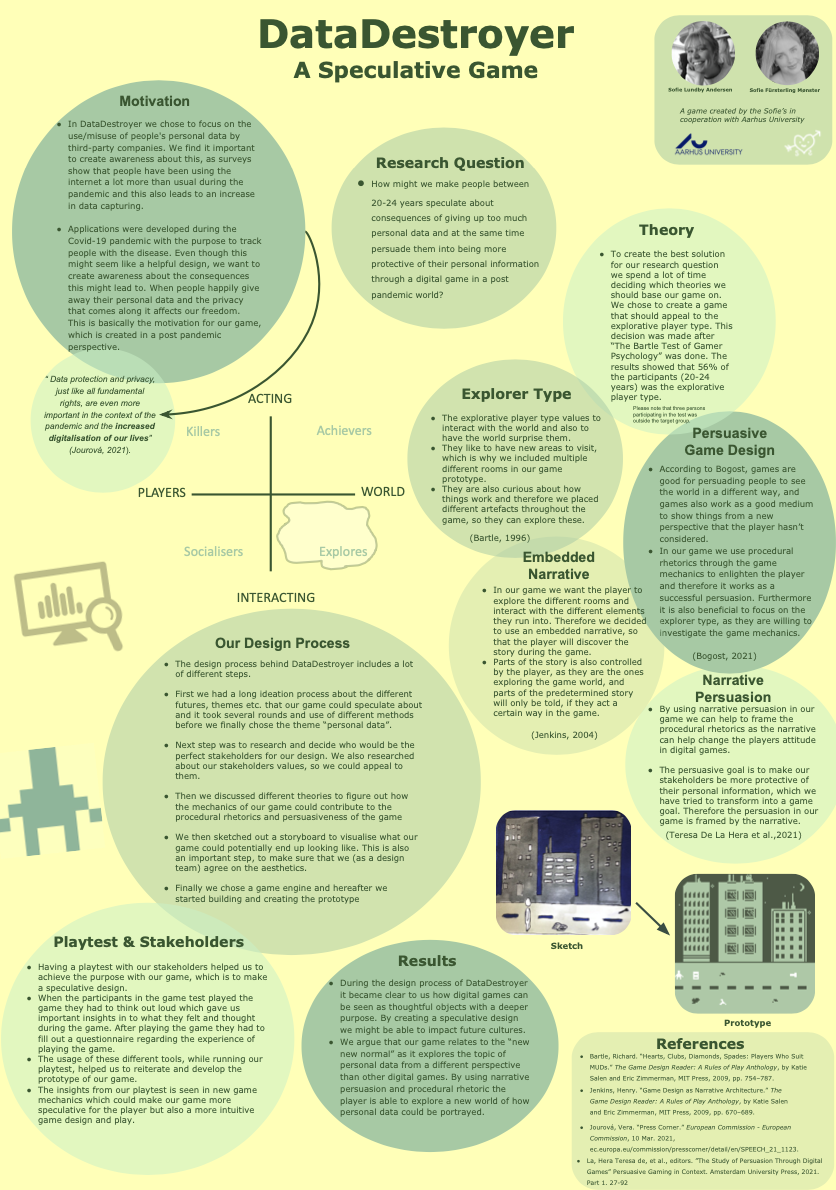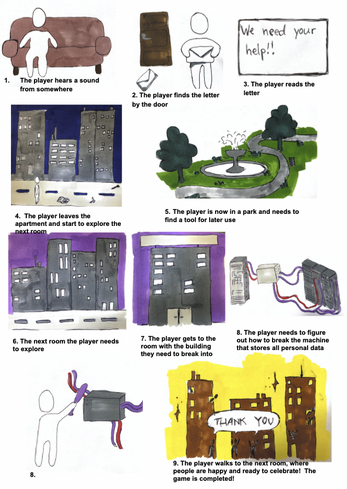DataDestroyer
DataDestroyer
How To Play
Use the arrow keys to control the character and to continue the dialogues.
PLEASE NOTE that the game works best in Safari or Chrome, as there might be problems with the sound if using other browsers.
Game Concept
DataDestroyer is an 8-bit exploring single-player game. It is created with the usage of the game editor tool Bitsy and made by "The Sofie's". As you can see in the scenario on the right side, the game features an explorative journey through a dystopian world. The people in the game live in the fear of their personal data being captured and that this will end up with them losing their freedom. The player has to help the citizens by finding the secret data storage room which is run by the evil data company. By following instructions from the narrative the player will discover and interact with the story. It is important that the player collect and interact with different artifacts to be able to move from one room to another and also to eventually complete the game.
DataDestroyer is made to be an explorative and speculative game. We hope that the players will start to act more awarefull and protective when it comes to their personal information, or at least that they will speculate about possible consequences that might occur in the future if too much personal information about us is being captured, used, and kept.
Theme
The overall theme for DataDestroyer is the post pandemic world and “the new new normal”. More specifically it focuses on the issue of how our personal data is being captured and used for and against us (see the moodboard for more inspiration). We chose this perspective as surveys show that our stakeholders have used the internet a lot more than usual during the pandemic (Jourová, 2021 ). Other reports made by the ReportLinker also showed that the usage of digital technologies has been increasing during the pandemic. “The COVID-19 pandemic has significantly increased the internet traffic between 25% and 30% during the initial lockdown period (March-April) worldwide, which is 10X times than normal growth...” (ReportLinker, 2021). We therefore chose to focus on creating a speculative game about how young people's personal data are being captured by third party companies. We were confirmed that this should be our main purpose with the game as our target group is younger people between 20-24 years and according to the European Commission Report from 2019, 98% of people in this age use the internet everyday (European Commission, 2019). At the same time socio-demographic analysis shows that the same group of people are least likely to see risks in their information being shared with third parties (European Commission, 2015).
Game Mechanics
The core game mechanics revolve around procedural rhetoric, as the game expresses its claims through rule based interactions. We sought to enhance the procedural rhetoric in the game by using persuasive tools to make the player speculate.
Our game works as a successful persuasion as we use procedural rhetorics through the mechanics in our game. By doing this we create opportunities for the player to see the world in a different way. In this case, it is also beneficial that we created a game for the explorative player type, as they are willing to investigate these game mechanics and therefore our game works as a great medium for showing the player new perspectives.
To strengthen the persuasiveness in our game we added an embedded narrative (Jenkins 2004). This will help the player discover the story throughout the game. The narrative persuasion in our game also helps to frame the procedural rhetorics, as the narrative in our game helps to change the player's attitude (De La Hera et al. 2021). By using the narrative we also make it easier for the player to immerse herself into the character, as there is both an opening and an ending to make the player reflect and speculate more about the protection of their personal data. The success of the persuasiveness of the embedded narrative depends on the playe-type we have chosen to focus on. We therefore chose the explorer (Bartle 1996) as our main player as they would discover the embedded narrative because of their curious nature. Artefacts, characters and small puzzles has been added to our game as this will be interesting for this player. These artefact are also part of the mechanics of the game and will add to the procedural rhetoric.
More Questions?
Sofie Lundby Andersen
Mail: sof.lundby.andersen@gmail.com
Sofie Fürsterling Mønster
Mail: sofiefmoenster@gmail.com
References
- Commission, European et al. “Data Protection Report” - European Commission, June. 2015.
- Commission, European et al. “ The General Data Protection Regulation” - European Commission, June. 2019.
- Jourová, Vera. “Press Corner”. European Commission - European Commission, 10 Mar. 2021.
- Jenkins, Henry. “Game Design as Narrative Architecture”. The Game Design Reader: A Rules of Play Anthology, by Katie Salen and Eric Zimmerman, MIT Press, 2009, pp. 670-689
- La, Hera Teresa de, et al., editors. ”The Study of Persuasion Through Digital Games” Persuasive Gaming in Context. Amsterdam University Press, 2021. Part 1. 27-92
Academic poster
The poster is also available for download at the bottom of the page.

Video pitch
| Status | Released |
| Platforms | HTML5 |
| Author | The Sofies |
| Made with | bitsy |


Comments
Log in with itch.io to leave a comment.
Great work on this! I enjoyed your prototype and hope you continue to make provocative games using innovative methods on this very Zeitgeisty topic.
By the way, if I’m not mistaken the sound track should be attributed as follows:
Machina by Scott Buckley - CC BY 4.0 - A glitchy, electronic ambient track evoking the atmospheric scores of classic 80’s science fiction.